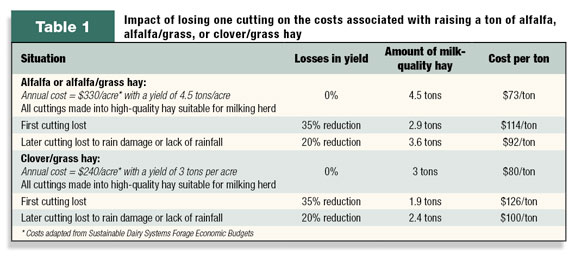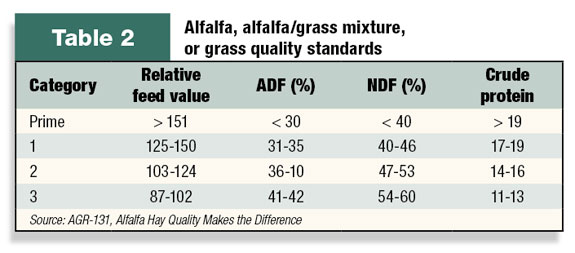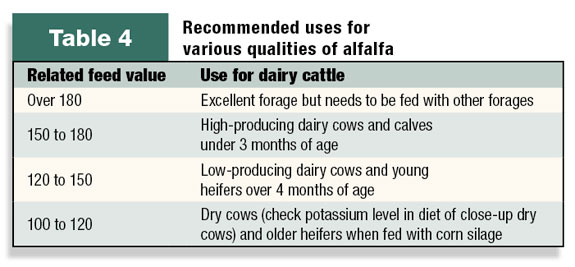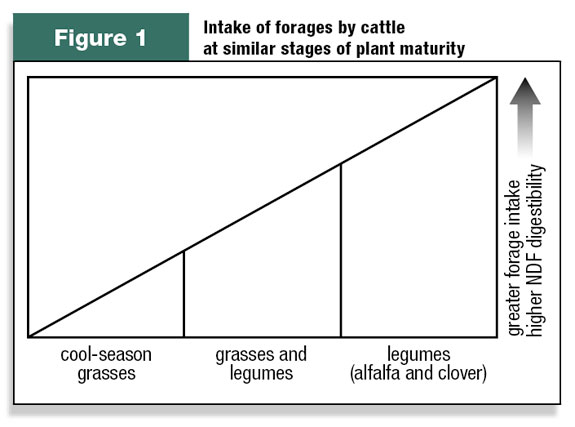Forages are the foundation for building diets for the dairy herd. The quality of these forages greatly impacts profitability and performance, especially of the milking herd. Because of limited land base, labor or personal preference, farmers may decide to purchase part or all of their herd’s forage needs. This article deals with considerations when purchasing hay, especially alfalfa or alfalfa/grass hay, for the milking herd.
Should I raise or purchase hay?
One question often asked is, “Should I raise my own alfalfa hay, or should I purchase what I need?”
When making this decision, you need to review not only the economics of raising your own alfalfa, but also whether you have the land and labor resources to devote to raising alfalfa hay, baleage, or silage. Specifically, you need to evaluate:
A. The best use of your available land and labor resources
- Do you have the land and labor resources to harvest the quality of alfalfa or alfalfa/grass hay needed by the milking herd?
- Are these resources better used elsewhere in your farming operation?
- Are you better off purchasing alfalfa hay and raising more silage on your farm?
- Are your labor resources better directed toward managing cows or other operations on your farm?
B. The costs associated with raising quality hay
- What does it cost you to raise an acre of alfalfa or alfalfa/grass forage?
- What quality of hay have you harvested over the past three years?
- How many tons of milk cow hay have you produced per acre in the past three years?
- On a tonnage basis, what has it cost you to raise alfalfa or alfalfa/grass forage for your milking cows?
- Would it have been cheaper to purchase or raise the amount of hay needed?
Economic budgets (on an annual basis) indicate it costs about $330 to raise an acre of alfalfa, assuming that the establishment costs are spread out over four years. If an alfalfa stand produces 4.5 to 5 tons per acre, it would cost $66 to $73 per ton of forage.

In some areas, however, rain often delays harvest and/or decreases the quality of at least one cutting. Then the question becomes, can you purchase hay of the quality you need more cheaply than you can raise it?
Table 1 illustrates how decreasing yields of quality hay impact the costs of producing hay for the milking herd.
Know the quality of hay you are buying
To determine the quality of hay or baleage you are buying, you must have the forage sampled and the quality analyzed by a forage testing laboratory.
To accurately determine the quality of hay for sale, a representative sample must be taken using a hay probe. Grab samples will not provide uniform samples for analysis.
For square bales of hay, 15 to 20 separate bales from each lot of hay should be cored using a hay probe. (A lot of hay is defined as hay from the same field that has been cut, handled, baled and stored under similar conditions.)
In a bucket, mix the samples thoroughly, and send a quart of material to a certified forage testing laboratory for testing and analysis.
The National Forage Testing Association (NFTA) certifies the accuracy of forage testing laboratories. Forage testing laboratories currently certified for either wet chemistry or NIR analysis can be found on the NFTA website ( www.foragetesting.org ).
Reading a forage analysis
Energy is the hardest nutrient to provide to cattle; therefore, the most important numbers on a forage analysis are acid detergent fiber (ADF) and/or neutral detergent fiber (NDF) content. These numbers ultimately relate to the amount of energy available to support milk production, growth and reproduction.
The ADF content reflects the digestibility and amount of energy cattle can obtain from the forage. The NDF content reflects the potential intake of a forage.
As the fiber content increases (both ADF and NDF), the digestibility, energy content and potential forage intake decreases. These changes ultimately affect performance and profitability.
Protein content is a distant second in importance to fiber content when determining which hay to purchase or feed to a group of cattle.
Relative feed value (RFV) is an index that compares the quality of a tested hay to full-bloom alfalfa hay that has been assigned a value of 100.
Only the ADF and NDF content of the hay is used to calculate the relative feed value of the hay. The protein content of the hay is not reflected in the relative feed value.

Within a type of hay, the higher the RFV, the greater the quality of the forage. Because alfalfa generally contains less fiber, alfalfa hay generally has a higher relative feed value than a grass hay at the same stage of maturity.
Table 2 lists the different quality standards for alfalfa or grass hay and their corresponding nutrient composition.
Purchase hay on weight and watch moisture content
Hay should be purchased based on weight and not size. As illustrated in Table 3 , when bales are priced on size, the weight of the package greatly influences the price paid per ton.

In addition, hay should contain no more than 14 percent moisture or less than 86 percent dry matter. Wetter hays are more prone to molding, and you pay additional money for the water in the hay.
Dairy-quality hay
High-producing dairy cows need alfalfa hay, which, after harvest, contains a relative feed value greater than 150.
Hay or silage that tests lower than this will increase feed costs and decrease profitability for the dairy herd. Forage that tests lower can be fed to those cattle that require lower amounts of nutrients relative to the high-producing dairy cow.

Table 4 lists the recommended uses for various qualities of alfalfa.
What about feeding Western alfalfa hay, which has an RFV over 200? Alfalfa hay with a relative feed value of 200 contains considerably less fiber than hay with a slightly lower relative feed value.
Alfalfa hay with an RFV greater than 200 acts like concentrates in a milking cow diet, and these diets need to be balanced as such.
In order to use these supreme quality hays, consult your nutritionist to make sure you have adequate amounts of effective fiber in the diet. These hays can be used effectively in diets for the milking herd, but they must be properly balanced to reflect their nutrient composition.

Quality of hay = Performance and profitability
With advancing stages of plant maturity, fiber digestibility and protein content of the alfalfa plant decreases while the amount of fiber increases.
Consequently, less energy is available to the cow when it consumes more mature alfalfa. Energy is the nutrient that most often limits performance in dairy or beef cattle – not protein.
Feeding high-quality forages results in greater feed intake and, as a result, dairy cows produce more milk, and they oftentimes can produce this milk more economically.
Classical studies done at the University of Wisconsin with mid-lactation dairy cows fed alfalfa hay as the sole forage found that for each 1 percent increase in NDF above 40 percent, the amount of alfalfa hay consumed by these cows decreased by 0.5 lb, and milk production decreased by 1 lb per day.
Feeding additional grain with lower-quality forages did not increase production to the amount seen when early cut, higher-quality forages were fed with lower amounts of grain.
This decrease in milk production can be seen even when as little as 5 lbs of alfalfa hay is fed. If we compare the difference in energy supplied by 5 lbs of hay with an RFV of 150 versus 115, the lower-quality alfalfa hay (RFV = 115) supports 1.5 fewer lbs of milk.
At current milk prices, a dairy farmer would generate $0.20 less daily income per cow with the lower- quality alfalfa hay if the ration was not rebalanced. For a 100-cow herd, this reduction in milk production could decrease milk income by $600 per month.
Put another way, profitability for this farmer would be equal if he or she spent an additional $80/ton for the higher-quality alfalfa hay. With the lower-quality alfalfa hay, intake is oftentimes decreased.
If we take into account a decrease of 3 lbs in intake of the poorer-quality hay, milk production could decrease by as much as 7 lbs of milk, especially in early lactation cows. The bottom line is that dairy farmers need to buy quality hay that has been tested for its nutrient content.
Alfalfa versus grass hay for the milking herd
Alfalfa is a forage crop that is not only high-yielding but (more importantly) is also an excellent source of energy, protein, fiber and minerals for dairy cattle. Intake potential is increased for alfalfa hay over grass hay at the same stage of maturity.
Also, alfalfa contains more energy than grass hay. Alfalfa is beneficial because it is an excellent source of both dietary energy and protein, and it has more digestible fiber and higher mineral content.
Excellent energy source .
High-quality alfalfa is an excellent source of energy. Energy is the hardest nutrient to provide in adequate amounts to support milk production and efficient reproduction. Thus, by feeding forages naturally higher in energy, it is easier to meet the energy needs of high-producing dairy cows.
In addition, alfalfa contains a highly digestible source of sugars, starches, and pectins (25 to 30 percent nonstructural carbohydrates), which the rumen bacteria can use as an energy source.
Also, alfalfa contains a highly digestible source of protein and neutral detergent fiber (NDF), which increases the amount of energy available to the cow when compared to grass forages.
Digestible protein source .
The protein found in alfalfa hay is highly digestible, and it contains a higher proportion of ruminally undegradable or bypass protein (RUP) (25 to 35 percent RUP) than grass hays.
Lower and more rapidly digestible NDF .
In general, NDF is slowly digested in the cow’s rumen; and as the amount of NDF from a forage increases, forage intake is decreased.
Since the NDF content of alfalfa is lower and more digestible than NDF from grass forages, this NDF is more rapidly cleared from the rumen, which stimulates intake.
Anytime feed intake is improved, performance is increased, especially with early lactation cows. A dairy farmer’s greatest profit is generated during the early lactation period.
In addition, alfalfa forage provides more buffering capacity in the rumen. This, in turn, helps buffer the pH changes in the rumen and helps decrease the incidence of health problems, such as ruminal acidosis.
Higher mineral content .
Alfalfa contains a greater concentration of calcium, phosphorus, potassium, magnesium, sulfur, iron, zinc and selenium than grasses. The concentration of minerals is greater and more available in alfalfa forage harvested at earlier stages of maturity.
From a practical and economical standpoint, minerals are relatively cheaply added to dairy cow diets as inorganic mineral sources so that the amount supplied through alfalfa does not greatly enhance performance or profitability. PD
—Excerpts from University of Kentucky College of Agriculture Cooperative Extension Service

-
Dr. Donna Amaral-Philips
- Extension Dairy Nutritionist
- University of Kentucky
- Email Dr. Donna Amaral-Philips






